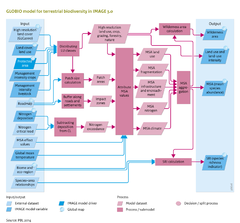Terrestrial biodiversity/Description: Difference between revisions
Jump to navigation
Jump to search
No edit summary |
No edit summary |
||
| Line 28: | Line 28: | ||
Nitrogen is a plant nutrient that stimulates growth, but some species benefit more than others and become more dominant with higher nitrogen availability. Thus, nitrogen deposition affects the species composition, mainly of plant and invertebrate species. Ecosystems can take up nitrogen without observable effects up to the level at which the assimilative capacity of the ecosystem is exceeded. This level of N input is defined as the critical load ({{abbrTemplate|CL}}). | Nitrogen is a plant nutrient that stimulates growth, but some species benefit more than others and become more dominant with higher nitrogen availability. Thus, nitrogen deposition affects the species composition, mainly of plant and invertebrate species. Ecosystems can take up nitrogen without observable effects up to the level at which the assimilative capacity of the ecosystem is exceeded. This level of N input is defined as the critical load ({{abbrTemplate|CL}}). | ||
Deposition rates of atmospheric nitrogen for current and future years are derived from IMAGE (Components | Deposition rates of atmospheric nitrogen for current and future years are derived from IMAGE (Components [[Emissions]] and [[Nutrients]]), and the map of critical loads is based on Bouwman et al. ([[Bouwman et al., 2002b|2002b]]). The nitrogen exceedance is calculated by subtracting the critical load from the estimated deposition. For forested and grassland ecosystems, the {{abbrTemplate|MSA}} map for nitrogen is derived from the regression equation between nitrogen exceedance and the proportion of remaining species. Regression equations are derived from published impact studies on the effects of a nitrogen surplus on species composition ([[Bobbink et al., 2010]]). | ||
===Infrastructure and Encroachment=== | ===Infrastructure and Encroachment=== | ||
Revision as of 21:24, 17 May 2014
Parts of Terrestrial biodiversity/Description
| Component is implemented in: |
|
| Projects/Applications |
| Key publications |
| References |
|
